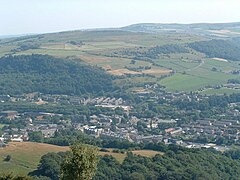Mytholmroyd
| Mytholmroyd | |
|---|---|
 View of Mytholmroyd from the north |
|
| Mytholmroyd shown within West Yorkshire | |
| Population | 3,949 (2011) |
| OS grid reference | SE012260 |
| Civil parish | |
| Metropolitan borough | |
| Metropolitan county | |
| Region | |
| Country | England |
| Sovereign state | United Kingdom |
| Post town | HEBDEN BRIDGE |
| Postcode district | HX7 |
| Dialling code | 01422 |
| Police | West Yorkshire |
| Fire | West Yorkshire |
| Ambulance | Yorkshire |
| EU Parliament | Yorkshire and the Humber |
| UK Parliament | |
Mytholmroyd /ˈmaɪðəmrɔɪd/ is a large village in Hebden Bridge, West Yorkshire, England, 10 miles (16.1 km) east of Burnley and 7 miles (11.3 km) west of Halifax. The village is in the Luddendenfoot Ward of Calderdale Council and forms part of the Hebden Royd parish.
Mytholmroyd was recorded in the 13th century as "Mithomrode" and in the 17th century as "Mitholmroide". The name means 'a clearing for settlement, where two rivers meet', likely derived from the Old English (ge)mȳthum (inflected form of (ge)mȳthe, "river mouth"), plus rodu ("field" or "clearing"). The l was probably inserted out of confusion with the common place-name element holm, Old Norse for a small island or eyot.
A Bronze Age urnfield exists on the moor top, north of Mytholmroyd. It is a burial ground with cremation urns, dating between the 16th and 11th Centuries BC of national importance. Evidence of pre-historic farming is apparent because they cleared the upland forests for cattle grazing and created the peat moorlands. Most of the Celtic Iron Age settlements were concentrated on the hillside terraces which avoided the wooded and poorly drained valley floors. Most of the older listed buildings are located on the hillsides away from the valley. A Roman coin hoard has been found to the south of Mytholmroyd.
During the late 18th century, the valley to the south, known as Cragg Vale, was home to a gang of counterfeiters known as the Cragg Coiners. The gang's leader, David Hartley, or King David as he was known, was found guilty of the 1769 murder of excise official William Dighton and was hanged at the York Tyburn on 28 April 1770. Two other gang members were also executed for their part in the murder.
...
Wikipedia

